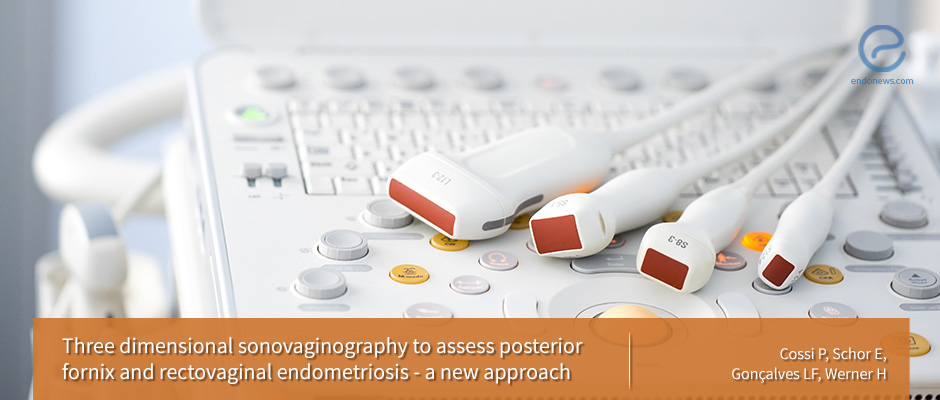Three dimensional sono-vaginography to diagnose rectovaginal endometriosis
Nov 8, 2018
A new approach to visualize the rectovaginal septum and posterior vaginal fornix for appropriate endometriosis diagnosis.
Key Points
Highlights:
- Three-dimensional sono-vaginography can be performed safely to assess rectovaginal endometriosis.
Importance:
- Rectovaginal endometriosis is the most severe form of deep infiltrating endometriosis. There are doubts about the diagnosis and treatment, due to the difficulty of the topography.
What’s done here?
- A new technique is described to increase the low sensitivity of transvaginal ultrasonography for deeply infiltrating endometriosis diagnosis.
- In addition to the routine transvaginal pelvic ultrasonographic examination, authors infuse the vagina with 60-80 mL of a homogeneous translucent gel.
- The partial-filled bladder and the anechoic gel in the vagina provide two acoustic windows to better visualize all anatomical planes in this anatomical region by 3-D ultrasonography.
Key results:
- The 3-D sono-vaginography which is the technique named as by authors provides an excellent view for the examination of the vaginal fornix, rectovaginal septum, and surface of the uterine cervix.
- The diagnosis of rectovaginal endometriosis is facilitated using this technique.
Lay Summary
Deep infiltrating endometriosis is defined as the localization of ectopic endometrial tissue penetrating more than 5 mm into the affected pelvic organs. Rectovaginal endometriosis is the most severe form of deep infiltrating endometriosis in which ectopic endometrial tissue infiltrating rectum and posterior vaginal fornix extends to the rectovaginal septum, and this form is the most difficult to diagnose.
Laparoscopic biopsy and histopathological confirmation are accepted as the gold standard for the diagnosis of endometriosis. However, the structures where the disease is localized, are not easy to visualize in some settings. The use of transvaginal ultrasonography in diagnosis has a limited value because of its low sensitivity.
Cossi et al, a group of scientists from Brazil and USA, developed a new technique named as three-dimensional sono-vaginography and published their study titled as “Three-dimensional sono-vaginography to assess posterior fornix and rectovaginal endometriosis – a new approach” in the journal "Ultrasound in Obstetrics and Gynecology". The authors aimed to facilitate the visualization of this topography. Authors describe this technique, where a catheter is inserted into the vagina deeply to infuse the vagina with a homogeneous translucent gel. During the examination, the partial-filled bladder and the anechoic gel in the vagina provide two acoustic windows to visualize all the anatomical planes in this anatomical region by three-dimensional ultrasonography.
“The simultaneous partial filling of the urinary bladder and presence of anechoic gel in the vagina creates two acoustics windows that facilitate visualization of the vesico-uterine pouch by three-dimensional transvaginal ultrasonography” they added.
Research Source: https://www.ncbi.nlm.nih.gov/pubmed/30288806
deep endometriosis transvaginal ultrasound rectovaginal septum vaginal fornix sonovaginography

